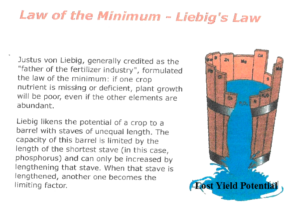
In essence, the barrel staves represent plant food nutrients at different levels of availability.
I’m a firm believer in the Law of the Minimum. Over the past 25+ years of scouting crops and troubleshooting problem areas in fields, including alfalfa, corn, soybeans, and winter wheat, I’ve used tissue sampling and soil sampling as my primary diagnostic tools to help fix the problem, or in other words “lengthen the shortest staves.” However, in these situations there has already been some top end yield loss for that year. Which brings up another point: Hidden Hunger.
Hidden hunger is a situation where a nutrient or nutrients are at low enough levels that they are limiting yields, but there are no visual signs of that nutrient deficiency. Sampling can also help to identify these hidden needs.
In closing, ask yourself:
- Have my yields leveled off the past few years?
- What changes have I made in my plant food nutrient program lately?
- Could hidden hunger be leveling off my yields?
Soil sampling and tissue sampling are great tools to help solve problems. If you answered “Yes” to questions 1 and 3 and “none” to number 2, maybe it’s time to take a closer look at the “stave lengths” on your operations, via tissue and soil sampling.
Get a hold of Andy, Mark, Kevin, Tom or myself if you see a need for some sampling to be done. It’s never too early to start planning for next year.
-Dan Langkamp
**Oh yeah, in case you are wondering, Justin Von Liebig was a German chemist from the 1800’s